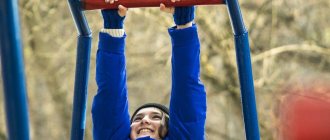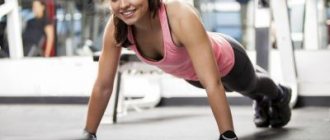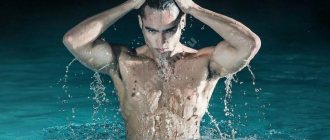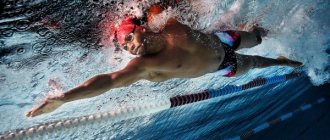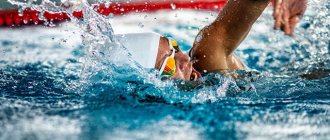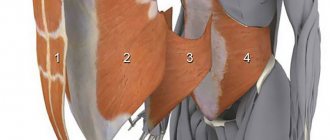Any sport involves serious stress, and our body’s resources are not always sufficient to withstand them. A striking example of this is the respiratory system, or popularly “breathing”. If it is not developed enough, then no amount of physical strength will lead to the desired result. Therefore, one of the main tasks for any athlete is the development of breathing.
As you already understand, good breathing is mainly of interest to those for whom sports and a healthy lifestyle are more than words or hobbies. Let's find out how to develop breathing in order to discover new heights in sports and make the body more resilient, which is much more important than any medals.
How to strengthen the respiratory system
The development of the respiratory organs is promoted by systematic aerobic exercise. Key sports that develop breathing include: running, swimming, mountaineering, cycling, rowing, speed skating and race walking. Exercise helps increase lung capacity and strengthen the heart. With regular exercise, the condition of the blood vessels improves: they become more elastic.
Aerobic exercise strengthens the body as a whole. Its ability to withstand heavy loads over a long period of time is called endurance. Don’t think that only professional athletes or law enforcement officers need endurance. A person leading an active lifestyle cannot do without it.
Who needs it and why?
A hike in the forest, a bike ride, working in the garden - all this and much more requires resources from the body. And even a long shopping trip can turn into a nightmare if you don't have enough stamina.
Trained and resilient people look much better than those who are lazy or constantly need special motivation. They are always fit, dignified, and, of course, there are no extra pounds. Such people move accurately, quickly, and confidently. However, external changes are only the first side of the coin. There are also internal changes. With constant and competent training, the composition of the blood changes (the number of red cells increases), which helps enrich the internal organs with oxygen. The respiratory muscles of trained people are stronger, as is the heart muscle.
Motivation
By and large, many people have known since childhood how to develop breathing and endurance. The simplest exercise for this is running. However, not everyone takes care of their health. Scientists have repeatedly proven that ancient people were incredibly strong, fast and resilient. They had to do a lot of cross-country running. Why did ancient people run so much? The answer is simple: to get food or not to become food ourselves. This example proves how big a role motivation plays.
Anyone who cannot convince himself that he needs to work for the sake of health will receive nothing but suffering from a sports lifestyle. After all, for quality training you need to give up your usual cozy and comfortable lifestyle. So you need to look at training as a way to add youth, positivity, beauty and a few valuable years to your life. It’s not enough to know how to develop breathing, it’s important to understand why it’s being done and to be able to force yourself.
How to breathe when swimming front crawl?
In this style, the face is almost constantly immersed in water, and the breath is taken at the moment when it emerges briefly, but is still very close to the surface. Breathing is coordinated with hand movements.
At that moment, when one goes down under water and is preparing to come to the surface, the second one flows forward. At this time, the athlete rests his ear on the front shoulder, turns his head to the side and inhales. In this phase, his gaze is directed towards the hand under water. When the latter comes out of the water and rushes forward for the stroke, the head turns face down, the swimmer begins to exhale through the mouth and nose.
There are unilateral and bilateral breathing. The first involves inhaling under the same hand, the second means alternating. The latter is more preferable, as it develops the necessary symmetry of movements, uniform rotation of the body, and improves the power of the stroke.
Every swimmer should know how to train bilateral breathing for swimming; there are special exercises for this. By the way, this skill is required in professional sports.
Possible mistakes:
- A small turn of the head due to insufficient body rotation. As a result, the swimmer is forced to twist his neck, which quickly gets tired and overloads the muscles;
- Turning the head too much (when the athlete manages to see the ceiling). As a result, the body rotates too much, which leads to loss of balance, wobbling and increased water resistance;
- The ideal turn of the face is when the lower eye is below the water line and the upper eye is above. The nose practically touches the edge. At first, instinct will force you to try to dive harder, but in the future, you will automatically and intuitively learn the required radius.
What kind of endurance is there?
The concept of endurance covers a fairly wide range of physical characteristics of the body. Respiratory endurance is mainly divided into two types: anaerobic and aerobic.
Anaerobic endurance expresses the body's ability to perform any physical work without the required amount of oxygen. That is, to perform some action, the body spends only internal resources. This type of endurance is developed by performing a large number of exercises in a limited period of time.
Aerobic endurance is the body’s ability to perform work using oxygen. This typically requires a variety of exercises with long sets.
There are also special and general endurance. The first is a distinctive feature of athletes who perform the same action for a long time, achieving perfection in it. Well, the second one is needed by ordinary people who are not chasing medals, but the health and tone of all the muscles and organs of the body. Everyone chooses for themselves what type of endurance to develop - it all depends on the goal.
Breathing depending on distance
If you have already mastered the crawl and were able to swim your first couple of hundred meters. You will most likely be faced with the question of how long to pause underwater and after how many strokes to inhale? It depends on what distance you are going to cover.
Sprint
If this is a sprint or you decide to test your abilities over a short distance, the best option is breath-hold swimming. Or with the least amount of breaths. Since unnecessary vibrations caused by twisting the body to inhale reduce the efficiency of the arms and legs. Thus, after the start, you perform the maximum number of strokes while holding your breath, then take a breath and row again for as long as possible.
At medium distances
At medium distances, both unilateral breathing (every second stroke) and bilateral breathing (breathing on both sides) are used. If you are swimming in a pool and breathe through an even number of strokes, it will be convenient to change the direction of inhalation every 25 or 50 meters.
Breathing while swimming is meditation and concentration. Everyone makes mistakes. Be calm, make movements consciously and you will be able to swim long, far and comfortably.
Bilateral breathing at 3, at 5
As we said earlier, bilateral breathing is when you inhale on the right and on the left side. An example of bilateral breathing would be breathing every 3 (3 after 3) or every 5 strokes. Thus, when breathing every third or every fifth stroke, you will always inhale on different sides. This is useful for several reasons:
- Your technique gets better. When inhaling on the same side, you always have the same supporting hand. Swimming technique becomes better with symmetry of loads and movements.
- Swimming in open water will make it easier for you to navigate. You will be able to look in both directions without having to stop.
Over long distances
Long or distance races, such as the Oceanman or Bosphorus races, are usually completed without holding your breath, breathing to one side (every second stroke). If you have worked well on bilateral breathing and it is not difficult for you to swim breathing in both directions, this will be a plus over long distances! You don't have to change anything!
If you are swimming for results, then bilateral breathing is not entirely suitable for long races. A long swim at a high pace while holding your breath will sooner or later affect your well-being due to lack of oxygen. Leave it as a strategic reserve. Use biteral breathing at different moments along the distance. This strategy will help you not to lose sight of your opponents and stretch your neck muscles.
How to develop breathing for running
This is a fairly common question, since many people run, and the lion's share of them are not professional athletes. Such people usually have no problems with excess weight, their body is always in good shape, and their mood is high. While jogging, the respiratory organs begin to work much faster, and the blood is enriched with oxygen, supplying the internal organs and the brain.
If you are starting to join the running culture, then you should pay attention to three main principles: gradualism, consistency, and acceptability. Let's look at each of them.
- Gradualism. From the first day you should not take on hours of training. You need to increase the distance carefully, controlling the pace and your condition. Those who decide to use running to restore their respiratory system after smoking should be especially careful with the intensity of their training. It must be remembered that the body must rest well and recover from the stress it has endured.
- Systematicity. To achieve even the smallest results, you need to perform exercises regularly. This is the only way to improve your endurance and physical condition.
- Eligibility. The load should be enjoyable and nothing else. If every workout is torture, but you run twice as much, soon the desire to run will disappear. Let it be better the other way around – a short run, done correctly and with pleasure.
Why do you need to be able to breathe correctly?
So, what does proper breathing affect when swimming in the pool:
- Speed in mastering the technique of each style;
- To the swimmer's endurance level;
- On the coordination of the athlete in the water-air space and the correct position of the body in the water;
- On the correct distribution of the load on the cardiovascular, respiratory systems, as well as on the spine. When breathing is done correctly, it is easier for the heart and lungs to work, this is understandable without explanation. But what does the spine have to do with it? It's simple. If an athlete does not know how to breathe correctly, then during movements he will strain his neck to keep his head above the surface. As a result, he will quickly get tired and overload the spine.
- On indicators of training effectiveness and the swimmer’s personal result;
- For the athlete’s comfort, because if he has the correct breathing technique when swimming, it means that training is easier and easier for him, he gets tired less, and swims further. Remember, the pleasure a person gets from playing sports is the main motivational factor for their further continuation.
- For the spectacle of movements. We have all seen competitive swimming competitions on TV, and some have seen them live. Agree, the swimmers’ movements look very beautiful and rhythmic. If they had not had the correct breathing technique, believe me, everything would not have looked so impressive.
We hope we have convinced you that you need to learn to breathe correctly while swimming in the pool. Moreover, this part of the technique should be given no less attention than the mechanics of movements of the arms and legs.
Next, we will tell you how to learn to breathe correctly when swimming. Let's start with general recommendations, and then move on to analyzing each style specifically.
Home workouts
Many people are interested in how to train breathing for running at home. Of course, to be good at running, you need to run. But you can make your body more resilient and your body fit at home. To do this, you don’t need to buy expensive exercise equipment. Any physical exercise (push-ups, pull-ups, jumping jacks, etc.) has a positive effect on respiratory endurance. An excellent exercise is jumping rope. Jumping rope will not only help tighten the whole body, but will also give a good workout to the respiratory system. A very simple way to develop breathing at home is to inflate balloons. This simple procedure perfectly trains the lungs and heart.
Training in water
Many people are interested in how to train breathing for running at home. Of course, to be good at running, you need to run. But you can make your body more resilient and your body fit at home. To do this, you don’t need to buy expensive exercise equipment. Any physical exercise (push-ups, pull-ups, jumping jacks, etc.)
) have a positive effect on respiratory endurance. An excellent exercise is jumping rope. Jumping rope will not only help tighten the whole body, but will also give a good workout to the respiratory system. A very simple way to develop breathing at home is to inflate balloons. This simple procedure perfectly trains the lungs and heart.
No, not underwater - although that's not bad either. The body in water experiences additional stress, it has to overcome the resistance of the elements. Consequently, the lungs also strain, trying to supply more oxygen to the blood. Training with weights while standing up to your neck in water will be both easier and more difficult than on land. Easier - because the weights will become lighter, heavier - because you are probably not used to this type of exercise.
If you are interested in developing your respiratory system at home, you will need the following activities:
- Warm up.
- Run.
- Jumping rope.
- Vocals
- Inflating rubber balls.
- Hitting the bag.
- Shadow fights.
The program begins with a warm-up. Rotational actions are performed to warm up all joints and tendons, and stretching actions are performed.
Each breathing exercise at home helps develop the chest and lungs. Running brings the greatest effect. You can do it at home if you have a special simulator. But it is better to run in nature and in the morning. You can choose a suitable area or route near your home for these tasks. It’s great if there is a forest, a park or just a school with a stadium nearby.
Exercises for breathing when running at home on a simulator or similar exercise in nature are as follows:
- Changing speakers. At first, the pace is slow. After 400-500 m, accelerate (press the corresponding button on the vehicle). Work at this pace for a minute and slow it down again. After 300-400 m, speed up again and calm down. And such cycles are carried out from 5 to 10 during a running workout.
- Monitor your breathing: inhale through your nose, exhale through your mouth. Inhale – a maximum of 3 seconds, exhale – a second.
- Exercise to develop the respiratory tract. Done after a run. As you walk, take light inhalations and slow exhalations. Use your lips to imitate the pronunciation of the sounds “F” and “W”. The duration of the exhalation is such that you mentally count down to 14.
Exercises for the development of the respiratory tract and chest have a significant effect. They can be easily arranged at home. Their implementation is as follows:
- Hand positions – shoulder line. They move sharply straight, to the left, to the right, up and down.
- Special chest massage. Hit it with your fists as if you were cooking a chop, but don't overdo it.
Punching a punching bag is an excellent exercise for improving your breathing. Performed on a regular basis, for example 2-3 times a week for 10-15 minutes.
The training can be divided into 2-3 rounds, in each round attack the projectile without pauses and at an intense pace. Then rest - a minute. And similar work is repeated.
In the absence of the designated product, he arranges shadow fights. Attack the air in turn with both hands, then with your feet. Constantly move, change positions and gradually build up the pace. Duration – 20-30 minutes. The work can also be divided into rounds.
Jumping rope has been known since childhood. They are very useful for breathing. You need to jump at different paces, starting with simple movements. The task is not to lose your breath in extreme mode. You determine the duration yourself, taking into account your level of preparation. But at least 10 minutes are allotted for this exercise.
Inflating rubber balls is an extremely useful exercise for increasing breathing capacity. It is easy to purchase these products. The task is to inflate them as much as possible, taking into account your maximum. Indicators need to be developed systematically. For example, on Monday you inflated 7 balloons, on Wednesday – 8, on Friday – 9, etc.
Vocal classes require hearing and musical notation. This is true if you study music thoroughly. To develop your breathing, you can borrow the following exercises from this program:
- Inhale as much air as possible. Straighten your shoulders and chest. At this moment, the lungs act as filled balloons. Do not breathe for 10 seconds. Exhale smoothly, turning your lips into a tube. This creates the effect of a deflating balloon. The air gradually comes out. Repeat the exercises. Just hold your breath for 20 seconds. In the next cycle, the delay is already 30 seconds, etc. in such a progression. Number of cycles – minimum 3.
- Similar exercise to step 1. Only exhalations are made sharply. The task is to empty the “balloon” in 3-5 exhalations.
- Take air into your lungs. Puff out your cheeks and hum in the lower register so that you can feel the vibration on your lips. Prolong the sound as long as possible. Repeat the exercise 2-3 times. Move up to the register and do the designated work. Raise to your maximum vocal pitch.
If you are into music and are familiar with the vocal craft, then you should be familiar with exercises on duration, intervals, pitch, etc. All this perfectly develops both the voice and the respiratory system.
How to train your breathing for swimming
Swimming, like running, is a sport in which breathing plays a crucial role, especially if it is swimming underwater. If a swimmer does not know how to breathe correctly, he will not be able to conquer long distances. Let's look at a couple of exercises to train breathing while swimming.
- While standing in the water, you need to inhale and immerse your face in the water, while holding your breath. Then you need to make two slow swings of your arms. Starting the second swing, you need to start exhaling air into the water; by the end of the swing, you should complete the exhalation and raise your head above the water. Then inhale and the exercise is repeated.
- The exercise is also performed at shallow depths. After taking a deep breath, you need to plunge into the water. Slowly exhale all the air so that the lungs become completely empty. After staying for a couple of seconds without air, you can come up and breathe again. Then everything is repeated. It is advisable to do this exercise energetically and rhythmically, spending a minimum amount of time above the water.
These exercises are very simple, but they answer the question of how to develop breathing for swimming underwater and just swimming.
Top 9 breathing exercises:
Let's look at the 9 best breathing exercises:
Belly breathing:
To perform this exercise, you need to lie on your back and breathe deeply. Some pillows can be kept under the knees and neck to help the stomach rise as you inhale and fall as you exhale. Perform for approximately 5 minutes.
"Buzzing" breathing:
For this exercise, you need to make a long humming sound as you exhale while keeping your abdominal muscles pulled inward.
"Chinese" breath:
This breathing exercise involves taking short breaths through the nose without exhaling. It also relaxes the mind and body by providing oxygen needed for the body's metabolism.
Exhale sharply while bending over:
For this exercise, simply stand flat on the ground and bend down to your heels. Exhale all the air from your lungs and then return to an upright position.
Ribs stretch:
You need to stand upright and stretch to one side. Then inhale slowly to maximize your lung capacity. Then hold your breath for 20 seconds.
Abdominal breathing:
Starting position: lying on your back, one hand on your stomach, the other on your chest. Once in the correct position, inhale and exhale slowly through your mouth.
Anuloma-Viloma pranayana:
This breathing exercise is good for the body and can be done as a warm-up before performing deep breathing exercises. It is mainly done to improve lung function and clear the airways for greater oxygen flow. This alternative form of nostril breathing is beneficial and can even reduce stress.
Cardiovascular exercises:
[Jumping Jack, Jumping Squats, Jumping Lunges]
These exercises can also be done to breathe in fresh air and are beneficial in that they can help a person quit smoking.
Aerobics:
These exercises can be performed to improve your breathing efficiency. These include: running, cycling and skating. They also lead to improved breathing and overall elasticity of the body.
The main goal of such exercises is to supply the body with as much oxygen as possible for the healthy functioning of all body systems. Thus, it is necessary to follow the correct technique and to obtain the desired results, you must definitely feel the expansion of the chest cavity.
If you have any doubts, talk to your trainer or watch some YouTube videos to make sure you have the correct technique. Once you can do these exercises regularly, your lungs will thank you and become healthier, which in turn will provide a better supply of oxygen to the rest of your body. So, take a deep breath and get to work!
If you liked the article, share it on social networks! Thank you!
